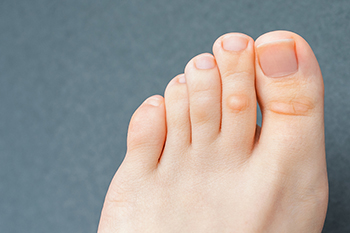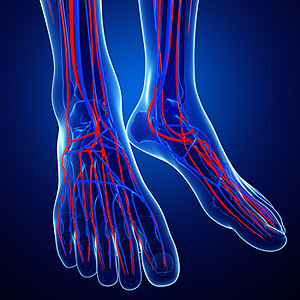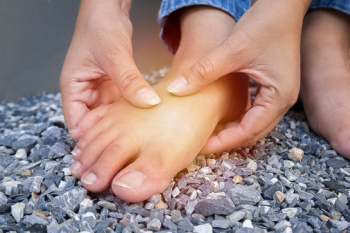Items filtered by date: July 2024
Causes and Relief for Foot Corns

Foot corns, small areas of thickened skin that develop from repeated pressure or friction, have various causes. Wearing ill-fitting shoes that squeeze toes or cause rubbing are common culprits. High heels and narrow shoes can also contribute by concentrating pressure on specific areas of the foot. Additionally, abnormalities in foot structure, such as hammertoes or bunions, may increase the likelihood of developing corns. Finding relief involves addressing the underlying cause, which can include wearing properly fitted shoes with adequate toe room and cushioning to reduce friction and pressure. Pads or cushions placed over corns can provide additional protection and alleviate discomfort. Avoiding excessive rubbing or picking at corns is essential to prevent infection. If corns persist or cause severe pain, it is suggested that you consult a podiatrist for effective treatment options.
Corns can make walking very painful and should be treated immediately. If you have questions regarding your feet and ankles, contact Glenn Aufseeser, DPM of Lakewood Foot and Ankle Specialists. Our doctor will treat your foot and ankle needs.
Corns: What Are They? And How Do You Get Rid of Them?
Corns are thickened areas on the skin that can become painful. They are caused by excessive pressure and friction on the skin. Corns press into the deeper layers of the skin and are usually round in shape.
Ways to Prevent Corns
There are many ways to get rid of painful corns such as:
- Wearing properly fitting shoes that have been measured by a professional
- Wearing shoes that are not sharply pointed or have high heels
- Wearing only shoes that offer support
Treating Corns
Although most corns slowly disappear when the friction or pressure stops, this isn’t always the case. Consult with your podiatrist to determine the best treatment option for your case of corns.
If you have any questions please feel free to contact our offices located in Lakewood and Manchester Township, NJ . We offer the newest diagnostic and treatment technologies for all your foot and ankle needs.
Choosing Running Shoes for Different Foot Types

Selecting the right running shoes depends on your foot type, which can be neutral, pronated, or supinated. Neutral feet have a balanced arch and typically benefit from shoes offering moderate cushioning and support. These shoes help absorb shock evenly during running. Pronated feet tend to roll inward excessively, requiring stability shoes with features like dual-density midsoles or medial posts to provide additional support and correct alignment. Supinated feet, which roll outward, benefit from neutral cushioned shoes with ample flexibility and cushioning to absorb impact and provide comfort. When choosing running shoes, consider arch height, gait analysis, and personal comfort preferences. Wearing shoes that are incorrect for your specific foot type may lead to developing foot pain. If this applies to you, it is strongly suggested that you consult a podiatrist who can provide relief and treatment options, and guide you toward the right pair of running shoes.
If you are a runner, wearing the right running shoe is essential. For more information, contact Glenn Aufseeser, DPM from Lakewood Foot and Ankle Specialists. Our doctor can provide the care you need to keep you pain-free and on your feet.
Choosing the Right Running Shoe for Your Foot Type
To increase performance and avoid the risk of injury, it is important to choose the right running shoe based on your foot type. The general design of running shoes revolves around pronation, which is how the ankle rolls from outside to inside when the foot strikes the ground.
- Neutral runners are able to choose from a wide variety of shoes, including minimalist shoes or even going barefoot.
- Runners who overpronate, or experience an over-abundance of ankle rolling, should choose shoes that provide extra motion control and stability.
- Runners who underpronate, or supinate, have feet that have high arches and lack flexibility, preventing shock absorption. They require shoes with more flexibility and cushion.
If you have any questions please feel free to contact our offices located in Lakewood and Manchester Township, NJ . We offer the newest diagnostic and treatment technologies for all your foot and ankle needs.
Symptoms of Poor Circulation in the Feet

Poor circulation in the feet manifests through various symptoms, possibly indicating underlying health issues. Cold feet are a common sign, often accompanied by tingling or numbness due to reduced blood flow. Swelling can occur as fluid accumulates, causing discomfort and making it difficult to wear shoes. Pain and a sense of heaviness in the feet may also develop, impacting mobility and daily activities. Discoloration, such as a bluish or pale hue, suggests insufficient oxygen supply. Additionally, poor circulation can lead to itchy rashes or dry skin, exacerbating discomfort. Improving circulation through lifestyle changes, medical treatments, and proper foot care may alleviate these issues. If you have any of the above symptoms, it is suggested that you consult a podiatrist who can diagnose and treat poor circulation.
While poor circulation itself isn’t a condition; it is a symptom of another underlying health condition you may have. If you have any concerns with poor circulation in your feet contact Glenn Aufseeser, DPM of Lakewood Foot and Ankle Specialists. Our doctor will treat your foot and ankle needs.
Poor Circulation in the Feet
Peripheral artery disease (PAD) can potentially lead to poor circulation in the lower extremities. PAD is a condition that causes the blood vessels and arteries to narrow. In a linked condition called atherosclerosis, the arteries stiffen up due to a buildup of plaque in the arteries and blood vessels. These two conditions can cause a decrease in the amount of blood that flows to your extremities, therefore resulting in pain.
Symptoms
Some of the most common symptoms of poor circulation are:
- Numbness
- Tingling
- Throbbing or stinging pain in limbs
- Pain
- Muscle Cramps
Treatment for poor circulation often depends on the underlying condition that causes it. Methods for treatment may include insulin for diabetes, special exercise programs, surgery for varicose veins, or compression socks for swollen legs.
As always, see a podiatrist as he or she will assist in finding a regimen that suits you. A podiatrist can also prescribe you any needed medication.
If you have any questions, please feel free to contact our offices located in Lakewood and Manchester Township, NJ . We offer the newest diagnostic and treatment technologies for all your foot care needs.
Are You Suffering From Ingrown Toenails?
Foot Conditions That May be Linked to Thyroid Disease
 Thyroid disease can lead to various foot conditions that impact daily comfort and mobility. Cracked heels are a common issue, resulting from dry skin associated with an underactive thyroid. Itchy feet may also occur due to the same dryness and reduced circulation. Cold feet are another symptom, as thyroid disorders often lead to poor blood flow. Swelling in the feet and ankles can arise from fluid retention linked to thyroid imbalance. Additionally, foot cramps are frequent due to disrupted electrolyte balance and nerve function. These symptoms highlight the need for thyroid management and regular foot care. Moisturizing regularly, wearing supportive footwear, and monitoring foot health can alleviate discomfort. If you suffer from a thyroid disorder and have problematic foot conditions, it is suggested that you consult a podiatrist who can offer you effective relief and treatment options.
Thyroid disease can lead to various foot conditions that impact daily comfort and mobility. Cracked heels are a common issue, resulting from dry skin associated with an underactive thyroid. Itchy feet may also occur due to the same dryness and reduced circulation. Cold feet are another symptom, as thyroid disorders often lead to poor blood flow. Swelling in the feet and ankles can arise from fluid retention linked to thyroid imbalance. Additionally, foot cramps are frequent due to disrupted electrolyte balance and nerve function. These symptoms highlight the need for thyroid management and regular foot care. Moisturizing regularly, wearing supportive footwear, and monitoring foot health can alleviate discomfort. If you suffer from a thyroid disorder and have problematic foot conditions, it is suggested that you consult a podiatrist who can offer you effective relief and treatment options.
When dealing with systemic disease of the feet, it is extremely important to check the affected areas routinely so that any additional problems are caught quickly. If you have any concerns about your feet and ankles contact Glenn Aufseeser, DPM from Lakewood Foot and Ankle Specialists. Our doctor will assist you with all of your podiatric needs.
Systemic Diseases of the Feet
Systemic diseases affect the whole body, and symptoms usually are displayed in the feet. This condition can make a patient’s ability to walk unbearable. Systemic diseases include gout, diabetes mellitus, neurological disorders, and arthritis.
Gout – is caused by an excess of uric acid in the body. Common symptoms include pain, inflammation, and redness at the metatarsal/phalangeal joint of the base big toe. Gout can be treated by NSAIDs to relieve pain and inflammation, and other drugs that lower the acid levels in the body.
Diabetes mellitus – is an increase in the level of blood sugar that the body cannot counteract with its own insulin. Failure to produce enough insulin is a factor in Diabetes.
Diabetes of the Feet
Diabetic Neuropathy – may lead to damaged nerves and affect the feet through numbness and loss of sensation.
Peripheral Vascular Disease – can restrict the blood flow to the feet, and often times lead to amputation of the feet.
If you have any questions please feel free to contact our offices located in Lakewood and Manchester Township, NJ . We offer the newest diagnostic and treatment technologies for all your foot and ankle needs.
Common Causes and Definition of a Broken Foot

A broken foot, or foot fracture, refers to a break or crack in one or more of the bones in the foot. This injury can result from various causes, including trauma from a fall, a direct blow, or an accident. Sports activities that involve running, jumping, or sudden changes in direction can also lead to fractures due to the high stress placed on the bones. Osteoporosis, a condition that weakens bones, can make them more susceptible to fractures even with minor impacts. Symptoms of a broken foot include immediate pain, swelling, bruising, and difficulty bearing weight. Proper diagnosis and treatment is critical to ensure the bones heal correctly. Treatment options range from immobilization with a cast or splint to, in severe cases, surgical intervention. If you have broken your foot, it is suggested that you visit a podiatrist who can determine the best treatment for you.
A broken foot requires immediate medical attention and treatment. If you need your feet checked, contact Glenn Aufseeser, DPM from Lakewood Foot and Ankle Specialists. Our doctor can provide the care you need to keep you pain-free and on your feet.
Broken Foot Causes, Symptoms, and Treatment
A broken foot is caused by one of the bones in the foot typically breaking when bended, crushed, or stretched beyond its natural capabilities. Usually the location of the fracture indicates how the break occurred, whether it was through an object, fall, or any other type of injury.
Common Symptoms of Broken Feet:
- Bruising
- Pain
- Redness
- Swelling
- Blue in color
- Numbness
- Cold
- Misshapen
- Cuts
- Deformities
Those that suspect they have a broken foot shoot seek urgent medical attention where a medical professional could diagnose the severity.
Treatment for broken bones varies depending on the cause, severity and location. Some will require the use of splints, casts or crutches while others could even involve surgery to repair the broken bones. Personal care includes the use of ice and keeping the foot stabilized and elevated.
If you have any questions please feel free to contact our offices located in Lakewood and Manchester Township, NJ . We offer the newest diagnostic and treatment technologies for all your foot and ankle needs.

